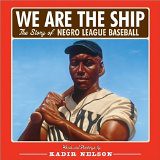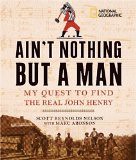It's Nonfiction Monday! And I'm talking about two more books that were on the Cybils short-list for MG/YA nonfiction, one of which I really liked, and one of which I really hated.
We Are the Ship: The Story of Negro League Baseball Kadir Nelson
This is a beautifully illustrated book about Negro League baseball. It won the Coretta Scott King honors for artwork and writing and it won the Sibert.
I'm still fuming.
I mean, it wasn't my favorite for King illustrator--it wasn't even my favorite Kadir Nelson book this year (I really liked his work in Abe's Honest Words) but I can understand why it won. I have much greater issues with the writing. I think it's an interesting story and kids will respond to the everyman first person narration, even though I find it fundamentally flawed. Not overjoyed with the writing winning an award, but also not surprised.
I am, however, extremely upset that it won the Sibert. There is NO WAY this book should be held up as a good example of nonfiction for kids.
Let's take another look at those illustrations. Many (possibly all) are based on real photographs. Yes, Nelson is an amazing painter and he breathed new life into those photos but... using paintings instead of photographs when they're obviously available? It makes the book less accurate, because instead of looking at real evidence, we're looking at an artistic interpretation of it.
And oh, the writing. History should NEVER be in first person if the author wasn't involved in the history. I know who Kadir Nelson is, and even I found myself asking at one point if he played for the Negro Leagues. Also, in taking the everyman approach, it makes the text confusing. When discussing how rough the players played, Nelson often says "they" or "them" but he's still in first person, so it sounds like these rough players weren't Negro league players--it sets up a horribly confusing us/them dichotomy.
Now yes, this first person narration makes the book vastly more appealing to kids, it's fundamentally not true and should not be held up as an example to strive for. How would you cite that in a paper? Can you imagine quoting something like this in a research project? How would you explain that yes, your quotation is in first person, but the person talking doesn't really exist? Will kids even realize that Nelson wasn't a baseball player? I had to go back and say "wait, what?" several times, and I consider myself to be a stronger and more experienced reader than most children, especially when it comes to history. And before you say that kids don't need to cite things and write research papers, yes, yes they do. And maybe not everything is a valid source, but if are going to give it an award for what children's nonfiction should be, then it should be a valid source. I don't lower my standards of nonfiction when it comes to stuff written for kids.
Nelson could have written a great and readable book in third person, but no. He chose something that makes his book less accurate, less true, and confusing to understand.
Also, there was no shout-out to the women who played in the leagues. No mention of them whatsoever.
Overall, yes, kids will really like this book. Yes, the pictures are beautiful. BUT! This is NOT what nonfiction for children should be. I'm dismayed that the Sibert committee thinks it is.
Ain't Nothing but a Man: My Quest to Find the Real John Henry Scott Reynolds Nelson
Now this is how you do history in first person. Scott Reynolds Nelson (not to be confused with Kadir Nelson, whom I discussed above) is a historian and was studying the man behind the myth presented in songs about John Henry. This can be told in first person because it's about Nelson's own story, his research process as he tracks down the real story.
Nelson shows how historians get ideas and clues from a lot of different areas and objects--not just letters and records, but postcard pictures, song lyrics, and maps. The reader learns a lot about the research process, but also reconstruction, prison labor, and how the railroads were built.
The design is super kid-friendly. My only complaint is a personal one. Nelson needed to look at some records at the archives that were closed. While he does explain all the reasons why records might be closed, his frustration paints the archivists kind of like bad guys. I understand not getting the records you need and how frustrating that is, but, as a trained archivist, I have a little more sympathy for the record keepers than Nelson does. :)
After reading the book, I had to listen to this on repeat for about an hour.
Round up is over at Miss Rumphius Effect.



3 comments:
Interesting perspective.
I absolutely loved the book -- for adults. It made a great old-dude-who-still-thinks-he-can-play-ball Christmas gift. I found it a beautiful book - but I love Kadir Nelson's artwork, and I thought the voice was very good. First person is a questionable choice for nonfiction, perhaps, but it's interesting it brought out such a strong reaction.
You know, had it not won the Sibert, I think I would have been OK with it. It's not my cup of tea, but it wouldn't have gotten such a strong reaction out of me. The fact that the Sibert (and other awards, I mean, it was short listed for the Cybil) are holding it up as an example of excellent nonfiction for kids is what makes me so upset.
It's a perfectly fine book that a lot of people will enjoy. It's NOT a perfectly fine work of nonfiction.
Thanks for the review of Ain't Nothing But a Man. I've loved the John Henry story since I was a little kid, long, long ago. I'll have to read this. My oldest girl will like this, too.
Post a Comment